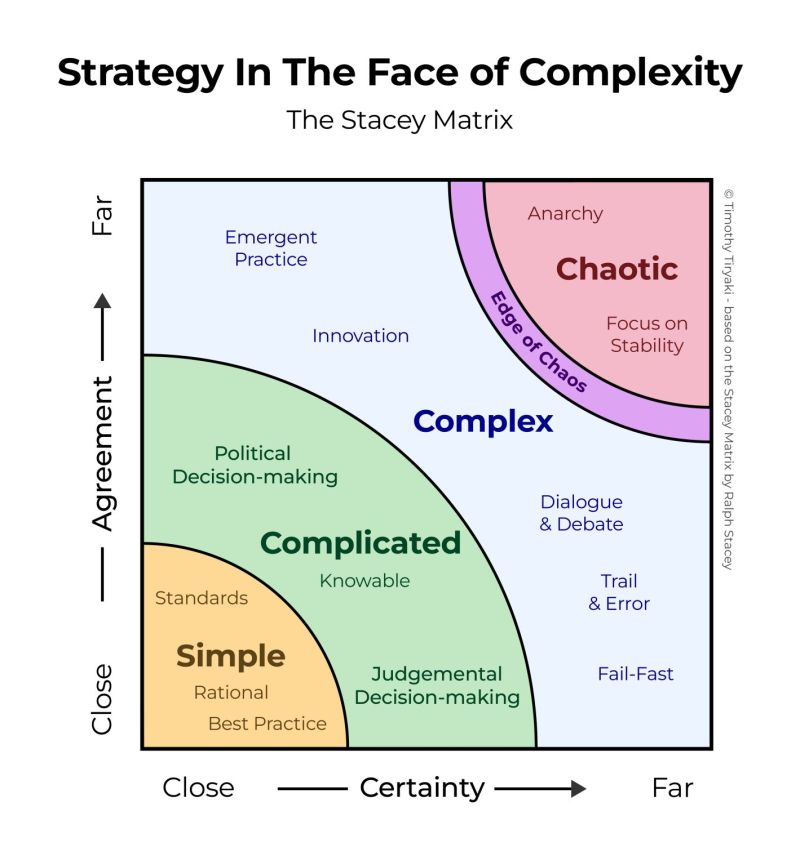Navigating Decision-Making in a Complex World: The Need for Clarity in Chaos
In an era defined by volatility, uncertainty, complexity, and ambiguity (VUCA), leaders grapple with challenges that defy traditional linear solutions.
Enter the Stacey Matrix, a seminal framework developed by British management scholar Ralph Douglas Stacey. Designed to guide decision-making in ambiguous environments, this model categorizes challenges based on their predictability and agreement levels, offering tailored strategies for each scenario.
This post delves into the Stacey Matrix’s four quadrants, explores its relevance in today’s post-pandemic world, and underscores the human-centered leadership skills required to thrive in complexity.
What Is the Stacey Matrix?
The Stacey Matrix, introduced in Ralph Stacey’s 1992 book Managing the Unknowable, posits that organizational challenges fall into four domains based on two axes:
- Certainty vs. Uncertainty (how predictable outcomes are).
- Agreement vs. Disagreement (how much stakeholders align on goals).
By plotting these dimensions, leaders can identify whether a problem is Simple, Complicated, Complex, or Chaotic—and choose the right approach accordingly.
Quadrant 1: Simple Challenges – Rationality Reigns
Characteristics:
- Clear cause-and-effect relationships.
- High certainty and stakeholder agreement.
Strategies:
- Best Practices: Standardized processes (e.g., ISO standards).
- Rational Decision-Making: Data-driven analysis.
Example: A manufacturing team optimizing production line efficiency using Six Sigma methodologies.
Reference: Harvard Business Review – The Value of Best Practices
Quadrant 2: Complicated Challenges – The Role of Expertise
Characteristics:
- Multiple solutions exist, but outcomes are predictable.
- Requires expert analysis and situational judgment.
Strategies:
- Political Navigation: Managing power dynamics.
- Scenario Planning: Anticipating risks (e.g., SWOT analysis).
Example: A healthcare organization implementing a new EHR system, balancing clinician input and regulatory requirements.
Reference: MIT Sloan – Navigating Complicated Decisions
Quadrant 3: Complex Challenges – Embracing Emergence
Characteristics:
- Unpredictable outcomes and shifting variables (e.g., market disruptions).
- Low certainty and disagreement on solutions.
Strategies:
- Trial and Error: Agile experimentation (e.g., Google’s “20% time”).
- Dialogue & Debate: Fostering psychological safety for diverse viewpoints.
Example: Netflix’s pivot from DVD rentals to streaming, driven by iterative testing.
Reference: Forbes – Thriving in Complexity
Quadrant 4: Chaotic Challenges – Stabilize First
Characteristics:
- Crisis situations with no clear path (e.g., natural disasters, cyberattacks).
Strategies:
- Immediate Action: Establish stability (e.g., Toyota’s “Stop the Line” protocol).
- Simple Solutions: Prioritize quick wins before tackling complexity.
Example: Airbnb’s rapid response to COVID-19, including cost-cutting and shifting to virtual experiences.
Reference: McKinsey – Leading in Chaos
The Stacey Matrix in a Post-COVID, VUCA World
The pandemic amplified global complexity, exposing flaws in rigid hierarchies. Organizations now operate in a polarized landscape where:
- Remote Work: Blurs geographic and cultural boundaries.
- Stakeholder Activism: Employees and customers demand ethical accountability.
VUCA Adaptation:
- Volatility: Use real-time data analytics (e.g., AI-driven dashboards).
- Uncertainty: Adopt adaptive strategic planning (e.g., rolling forecasts).
Reference: World Economic Forum – Leadership in VUCA
Human-Centered Leadership: The Key to Complexity
Stacey’s work underscores that complicated and complex realms demand soft skills:
- Empathy: Understanding stakeholder needs.
- Inclusive Decision-Making: Co-creating solutions with diverse teams.
Case Study: Microsoft’s cultural shift under Satya Nadella, emphasizing growth mindset and collaboration.
Training Opportunities:
- Human-Centered Strategy Certification: Learn to design inclusive frameworks.
- Executive Culture Coaching: Foster psychologically safe workplaces.
Reference: TED Talk – Satya Nadella on Empathy
Stacey Matrix vs. Cynefin Framework
While often compared to Dave Snowden’s Cynefin Framework, the Stacey Matrix uniquely emphasizes:
- Political Dynamics: Power structures in decision-making.
- Process vs. Emergence: Balancing control with adaptability.
Reference: Cognitive Edge – Cynefin Explained
Conclusion
The Stacey Matrix is not just a tool—it’s a mindset shift. In a world where 73% of leaders cite complexity as their top challenge (per Gartner), mastering this framework requires courage to embrace ambiguity and humility to learn from failure.
Further Reading:
- Stacey, R. D. (1992). Managing the Unknowable. Jossey-Bass.
- Harvard Business Review – Decision-Making in Uncertainty
- Gallup – Soft Skills for Hard Times


